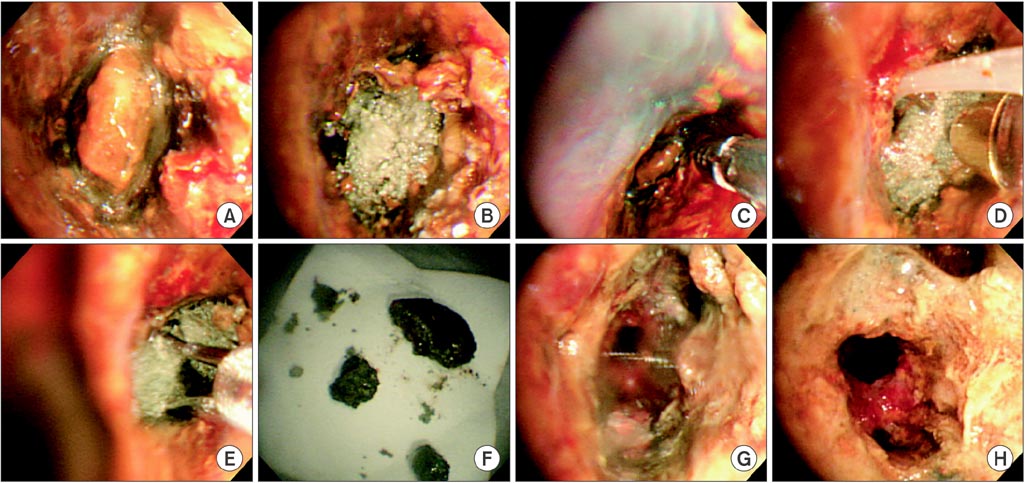Tuberc Respir Dis.
2016 Jan;79(1):37-41. 10.4046/trd.2016.79.1.37.
Severe Endobronchial Inflammation Induced by Aspiration of a Ferrous Sulfate Tablet
- Affiliations
-
- 1Division of Respiratory and Critical Care Medicine, Department of Internal Medicine, Korea University Guro Hospital, Korea University Medical School, Seoul, Korea. minkyunghoon@korea.ac.kr
- KMID: 2320754
- DOI: http://doi.org/10.4046/trd.2016.79.1.37
Abstract
- Iron supplements such as ferrous sulfate tablets are usually used to treat iron-deficiency anemia in some elderly patients with primary neurologic disorders or decreased gag reflexes due to stroke, senile dementia, or parkinsonism. While the aspiration of ferrous sulfate is rarely reported, it is a potentially life-threatening condition that can lead to airway necrosis and bronchial stenosis. A detailed history and high suspicion of aspiration are required to avoid delays in diagnosis and treatment. The diagnosis can be confirmed by bronchoscopic examination and a tissue biopsy. Early removal of the aspirated tablet prevents acute complications, such as bronchial necrosis, hemoptysis, and lobar consolidation. Tablet removal is also necessary to prevent late bronchial stenosis. We presented the first case in Korea of a ferrous sulfate tablet aspiration that induced severe endobronchial inflammation.
Keyword
MeSH Terms
Figure
Reference
-
1. Baharloo F, Veyckemans F, Francis C, Biettlot MP, Rodenstein DO. Tracheobronchial foreign bodies: presentation and management in children and adults. Chest. 1999; 115:1357–1362.2. Lamaze R, Trechot P, Martinet Y. Bronchial necrosis and granuloma induced by the aspiration of a tablet of ferrous sulphate. Eur Respir J. 1994; 7:1710–1711.3. Boyd M, Watkins F, Singh S, Haponik E, Chatterjee A, Conforti J, et al. Prevalence of flexible bronchoscopic removal of foreign bodies in the advanced elderly. Age Ageing. 2009; 38:396–400.4. Lee JO, Lee JH, Ahn S, Kim JW, Chang H, Kim YJ, et al. Prevalence and risk factors for iron deficiency anemia in the korean population: results of the fifth KoreaNational Health and Nutrition Examination Survey. J Korean Med Sci. 2014; 29:224–229.5. Mahmood K, Koubar S, Shofer SL, Ninan NA, Wahidi MM. Alendronate tracheobronchitis. Ann Am Thorac Soc. 2013; 10:64–66.6. Sundar KM, Elliott CG, Thomsen GE. Tetracycline aspiration: case report and review of the literature. Respiration. 2001; 68:416–419.7. Karakan Y, Akpinar A, Yildiz H, Aksoy H, Dikensoy O. A case of ciprofloxacin tablet aspiration. Tuberk Toraks. 2010; 58:97–99.8. Micallef J, Montefort S, Mallia Azzopardi C, Galea J. Two cases of aspiration of calcium tablets. Lung India. 2011; 28:312–314.9. Radiological notes: aspirated capsule in right lower lobe. J Mt Sinai Hosp N Y. 1966; 33:530–532.10. Cimino-Mathews A, Illei PB. Cytologic and histologic findings of iron pill-induced injury of the lower respiratory tract. Diagn Cytopathol. 2013; 41:901–903.11. Maw M, Chiu R, Lim AY. Bronchoscopic and histological changes over time following acute ferrous sulphate tablet aspiration. BMJ Case Rep. 2012; 2012:bcr2012007329.12. Venci NM, Watson TJ, Kallay MC. Bronchial stenosis following ferrous sulfate aspiration: case report and review of the literature. J Bronchology Interv Pulmonol. 2014; 21:58–60.13. Ceylan N, Bayraktaroglu S, Savas R, Alper H. CT findings of high-attenuation pulmonary abnormalities. Insights Imaging. 2010; 1:287–292.14. Lee P, Culver DA, Farver C, Mehta AC. Syndrome of iron pill aspiration. Chest. 2002; 121:1355–1357.15. Kim ST, Kaisar OM, Clarke BE, Vandenburg RA, Allen DH, Bell SC, et al. 'Iron lung': distinctive bronchoscopic features of acute iron tablet aspiration. Respirology. 2003; 8:541–543.
- Full Text Links
- Actions
-
Cited
- CITED
-
- Close
- Share
- Similar articles
-
- A Case of Significant Endobronchial Injury due to Recurrent Iron Pill Aspiration
- Iron Supplementation in a Girl with Attention-Deficit Hyperactivity Disorder
- The Effect of Splenectomy on Acute Barium Sulfate Induced Toxicity of Rat Organs
- Hyponatremic Seizure after Ingestion of an Oral Sulfate Tablet for Bowel Preparation for Colonoscopy
- Effects of Iron Supplementation on Attention Deficit Hyperactivity Disorder in Children Treated with Methylphenidate




